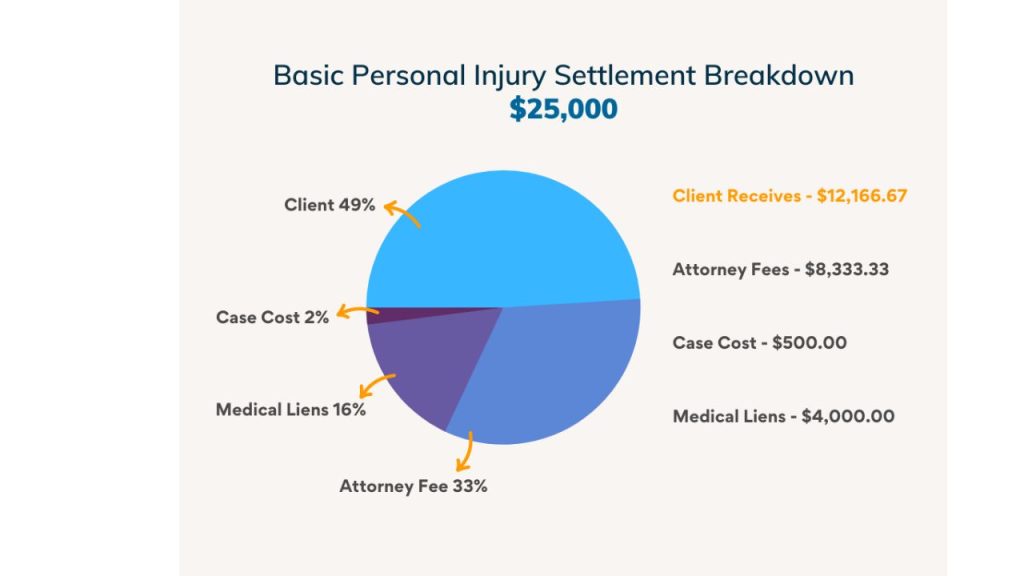The phrase “pain and suffering” is often used in the complex world of litigation, especially in situations involving personal injuries. Although the physical effects of an accident are simple to comprehend, measuring the psychological and emotional anguish may be very difficult.

In civil cases, pain and suffering are an essential component of compensatory damages, and a reasonable settlement depends on your ability to comprehend how personal injury attorneys determine it. A lawyer is necessary when determining pain and suffering in personal injury situations. They can put a number on the psychological and physical toll the accident has had on you. Attorneys can fight for just compensation that accounts for your suffering by calculating a monetary value. Your expectation of receiving a final settlement or jury award depends on this computation.
The Attorney’s Role in Damages Negotiation:
A lawyer’s duties go beyond calculating the cost of your suffering. In addition, they vigorously bargain with insurance companies and opposing attorneys, presenting your case before juries and judges to protect your rights and obtain just compensation.
Attorneys employ their expertise to present compelling cases that emphasize the severity of your trauma and its long-lasting consequences on your life. They might contend that the computed amount for pain and suffering represents a genuine and substantial adversity you have gone through rather than just being an abstract quantity.
Elements of Pain and Suffering:
No one formula works for all cases for calculating pain and suffering; instead, it depends heavily on the circumstances.
But in most cases, the following elements are involved:
- The degree of harm: The damages caused by pain and suffering increase with the severity of the injury. Long-term suffering or permanent disability from an injury usually entails a larger settlement.
- Medical costs: The price of medical care, medicine, and rehabilitation are essential markers of an accident’s physical toll. They also take into account the probable future costs you may incur.
- Emotional distress: Attorneys evaluate the psychological and emotional fallout from your injuries, taking into account things like PTSD, depression, and anxiety, in addition to the general impact of the accident on your quality of life.
- Impact on everyday life: The evaluation also considers how the injury has affected your relationships, employment capacity, and day-to-day activities.
- Implications for the future: The computation accounts for your possible discomfort, suffering, and continued medical expenses.
Each factor’s value will be used to calculate the overall damages. The severity of the injuries and medical expenditures are clear indicators of the bodily pain experienced.
While more challenging to quantify, emotional anguish is critical in revealing your mental suffering. Your injuries’ impact on your everyday activities, relationships, and work capabilities, as well as their possible long-term consequences, present a comprehensive picture of your agony.
Methods for Calculating Pain and Suffering:
The multiplier and per diem procedures are the two most frequent ways attorneys calculate the monetary worth of noneconomic losses. Both have advantages and disadvantages, and the best solution depends on the situation’s circumstances.
The Multiplier Method:
Lawyers frequently utilize the multiplier approach to calculate pain and suffering in personal injury lawsuits. This method calculates damages by multiplying economic losses, such as medical bills and lost income, by a fixed amount—the multiplier—with a more prominent figure for more severe injuries that need long-term rehabilitation and have long-term implications.
The Per Diem Method:
The per diem technique calculates a daily value for the victim’s pain and suffering. Lawyers then compound the daily rate, which is frequently similar to a day’s profits, by the number of days the victim’s agony lasts or until they reach their maximum recovery. If the daily wage is $100, and you endured for 200 days, your pain and suffering damages would be $20,000.
Lawyers frequently utilize this strategy in situations where they believe the victim will fully recover since it displays the impact of the damage on the victim’s everyday life.
While the multiplier approach allows for more significant rewards under challenging situations, it can be subjective since attorneys may advocate for alternative multipliers. The per diem technique, on the other hand, is more straightforward but may overlook the long-term consequences of the damage.
Although these methodologies give a framework, it is essential to note that quantifying pain and suffering is not an exact science, and these figures are frequently used as beginning points for negotiations rather than hard-and-fast guidelines.
How State Laws Can Impact the Calculation:
Each state has its own set of rules and regulations that control how pain and suffering damages are calculated. Certain jurisdictions limit the amount you may sue for pain and suffering, known as damage caps, particularly in medical negligence claims.
Some states use a fault system in personal injury lawsuits, which means that a victim’s compensation is determined by their part in creating the accident.
In no-fault states, plaintiffs often seek reimbursement from their insurance company before contacting the at-fault party. State laws usually specify the duration, or statute of limitations, within which a victim may file a case. This can significantly affect the computation and recoverability of pain and suffering damages.
The Role of Evidence in Calculating Pain and Suffering:
Your lawyer will use substantial evidence to demonstrate the amount of your pain and suffering.
This may include:
- Medical documents are crucial in a personal injury case. They fully summarize your injuries, treatments, and future prognosis. Medical records can give a detailed picture of your pain and discomfort as a result of your accident and subsequent treatment.
- Mental health documents, such as those from psychological treatment or therapy, psychiatric examinations, or mental disease diagnoses, might serve as evidence of your emotional anguish and sorrow.
- Personal diaries or journals: Documenting your daily experiences and feelings can provide compelling proof of your injury’s immediate and long-term impact.
- Testimony from family, friends, and coworkers: These people may confirm your physical suffering, mental condition, and changes in lifestyle or behavior following the event.
- Photos and Videos: Visual evidence of the injuries, treatment procedure, and lifestyle consequences may be robust evidence of your pain and suffering.
How Do Lawyers Gather and Present Evidence?
In personal injury cases, experienced attorneys use a variety of tactics to collect and present evidence. They may interview witnesses, seek medical advice, and work with private investigators or specialists. Their purpose is to provide a complete picture of your experiences and challenges.
Lawyers are critical to the effective presentation of evidence. They may blend information into a convincing story that addresses your pain and suffering. Your attorney may employ visual aids, expert witness testimony, and solid narrative tactics to bring the facts to life in court.
Hire an Experienced Personal Injury Attorney Now:
The process of measuring pain and suffering is anything but simple. It’s a fine line between objectivity and subjectivity, skillfully translating ethereal experiences into tangible compensating claims.
Your lawyer can provide a whole picture of your ordeal by knowing your tale, collecting solid facts, and using distinct mathematical procedures. They will argue for your rights and ensure you obtain sufficient compensation for your pain and suffering.
Read Also – Should You Get a Lawyer for a Car Accident that wasn’t your Fault?



